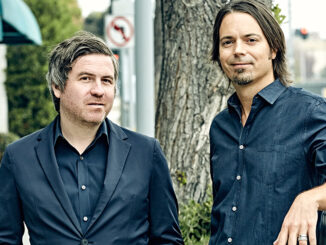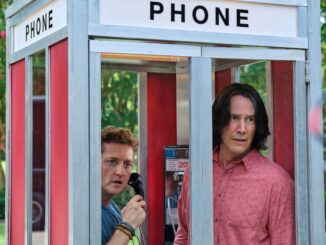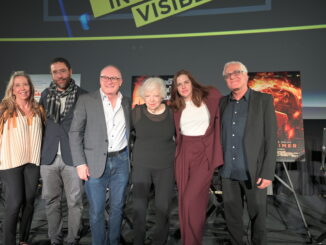
by Ray Zone
Letterboxed: The Evolution of Widescreen Cinema
by Harper Cossar
University Press of Kentucky Hardbound, 226 pps., $60.00 ISBN: 978-0-8131-2651-7
In the Jean-Luc Godard film Contempt (1963), director Fritz Lang, portraying himself, acidly jokes that CinemaScope “wasn’t meant for human beings. Just for snakes and funerals.” A few years later, in an interview, he added that with the widescreen format, “you have a close-up, and on either side, there’s just superfluous space.” Lang may have found widescreen unnecessary, but to this day it remains an enduring aspect of theatrical motion picture exhibition that has had both a technological as well as aesthetic impact.
With his new book on the evolution of widescreen, Harper Cossar has built upon prior studies, such as John Belton’s book Widescreen Cinema (Harvard University Press: 1992) and the seminal essay by Charles Barr, “CinemaScope: Before and After,” from a 1963 issue of Film Quarterly magazine (Vol. 16, No. 4). He also builds upon structures for theoretical analysis enunciated by prolific film scholar David Bordwell. Cossar’s work serves as a supplement to previous writing, and he adds, “Generally, I look at widescreen as a series of aesthetic experiments that result in either ruptures or new norms of film style.”
Acknowledging that “rupture” is a harsh term, Cossar precisely defines it as “a specific break with previous traditions of aesthetic composition, angle or movement,” and adds that it is “an accurate description of the industry-wide shift that occurred aesthetically in 1953 with the introduction of widescreen. The advent of widescreen as a new physical norm was an extreme, irreversible break in film style.” In expanding the scope of discus- sion about widescreen aesthetics, which usually addresses films of the 1950s and 1960s shot in the aspect ratio of 2.35:1, Cossar explores examples of it in silent films, early sound-era films and new media ventures of the present day, such as those online “that use a letterbox aesthetic to imitate widescreen processes.”
In addition to expanding the historical notion of widescreen films, Cossar has sought to “broaden the scope of widescreen aesthetics in terms of the number of films, auteurs and genres under consideration.” Cossar stresses the importance of genre and the auteur in his critical approach. “By and large, auteurs in the studio system made genre films, ” he writes. “By analyzing their unique renderings within generic vehicles, one can discern their stylistic and narrational signatures. It is within these devices, systems and signatures that widescreen is best interrogated and investigated.” Accordingly, Cossar examines the D.W. Griffith films Broken Blossoms (1919) and Orphans of the Storm (1921) as well as the Buster Keaton short The High Sign (1921) and his feature Our Hospitality (1923), along with Abel Gance’s Napoleon (1927) for widescreen “stylistic ruptures” in the silent period.
Auteurist applications of widescreen aesthetics in the early sound era are noted with The Big Trail (1930), shot in both 35mm and 70mm by director Raoul Walsh, and The Bat Whispers (1930), directed by Roland West and also shot simultaneously in both formats. The different formats provide a useful comparison of Academy Aperture, 1.33:1 and widescreen. “Both the directors and their cinematographers experimented with stylistic ruptures as they shot widescreen and Academy ratio versions simultaneously,” reports Cossar. “Issues of stylistic experimentation between the disparate versions are also apparent with regard to camera height and movement, not to mention a variety of considerations involving set design.”
In the 1950s, widescreen was often regarded as one of the box-office “saviors,” a “novelty deployed by an industry that needed a boost in profits” that was “unveiled only when it was deemed financially feasible to do so.” Otto Preminger’s River of No Return (1954) is generally regarded as a “canonical text” for widescreen scholarship. As an auteur, Preminger favored the long-take aesthetic and the absence of close-up inserts typical of conventional filmmaking––both stylistic practices that are eminently suitable for widescreen.
The aesthetic impact of the implemen- tation of CinemaScope can be compared to other technological innovations such as sound. In his book The Talkies: American Cinema’s Transition to Sound 1926-1931 (University of California Press: 1997), Donald Crafton discusses the issue of foregrounding. This is the prac- tice of showcasing and highlighting a technological change with “the unique or novel properties of a medium.” Foregrounding of new technology can be seen with sound in the profusion of the “All-singing, all-talking” musicals of the early 1930s and the hyperbole promoting “a lion in your lap, a lover in your arms” with the 3-D movies of the 1950s. “The conversion to sound,” writes Cossar, “produced many of the same challenges as that of widescreen—new aesthetic considerations, new technological trials and confusion over how best to use the new filmmaking tools.”
Other directors of the 1950s who made a notable artistic use of widescreen include Nicholas Ray with Rebel Without a Cause (1955) and The True Story of Jesse James (1957), and Frank Tashlin with The Girl Can’t Help It (1956) and Will Success Spoil Rock Hunter? (1957). “There is a magnificent moment in Will Success Spoil Rock Hunter?” observes Cossar, “when the CinemaScope (2.35:1) frame reduces to the proportions of a television screen (Academy ratio, 1.33:1) in order to mock the presumed competition posed by the ‘household’ technology of TV.” Such ruptures, adds Cossar, “represent the unique physical or stylistic foregrounding of widescreen aesthetics.”





